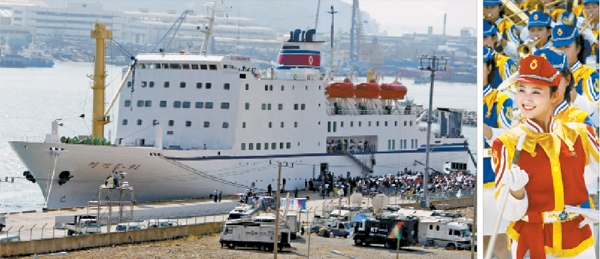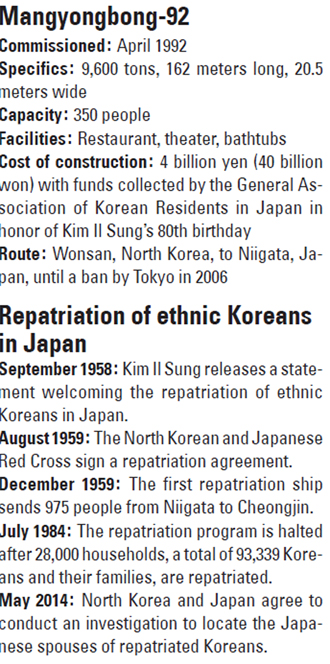History plays out on North Korean ferry

Left: The Mangyongbong-92 anchors at Dadaepo harbor in September 2002, carrying a cheerleading squad from North Korea for the Asian Games in Busan. The 9,600-ton vessel housed the squad and was where the girls were provided meals. Right: Pyongyang’s team of fresh-faced young cheerleaders attend the 2002 Asian Games in Busan. [JoongAng Ilbo]
The cheerleaders, all fresh-faced pretty young women, caught the public’s eye in September 2002, when Pyongyang’s 288-member squad arrived aboard the 9,200-ton vessel before the Asian Games in Busan.
For the sporting event this fall, scheduled for Sept. 19 to Oct. 4, North Korea plans to send a team of 350 cheerleaders, who are expected to be sent to the games separately, via a direct flight on Air Koryo from Pyongyang to Incheon.
Pyongyang threatened to pull out of the games after botched working-level talks between North and South Korea on July 17 at the Panmunjom truce village on the southern side.

From 1959 to July 1984, approximately 93,339 ethnic Koreans in Japan and their families were sent back to Pyongyang through a mass repatriation campaign initiated by the General Association of Korean Residents in Japan, or Chongryon, which served as the de facto Embassy of North Korea in Tokyo.
The Mangyongbong passenger ship originally served that purpose, and made its first voyage in 1971, transporting ethnic Koreans living in Japan from Niigata to North Korea’s port city of Wonsan in Kangwon Province.
Earlier this month, the JoongAng Ilbo traveled to Niigata Prefecture, on the western coast of Japan, a gateway for the passage of ships from North Korea.
Reporters accompanied a group of college students - all North Korean defectors who are part of the Korea Unification Leadership Academy affiliated with the Ministry of Unification - to the site where thousands were shipped back to the Communist North over some 25 years.
In Niigata City, 305 willow trees are planted along a road now named Botonamu Street, to memorialize their repatriation and the difficulties that it brought.
Among the defectors was a college student whose parents had been two of the North Koreans repatriated to their home from Japan.
The 24-year-old student’s father was sentenced to life in a concentration camp for his ideologies.
“I wonder what sort of hope my mother and father had when they boarded the Mangyongbong,” she said.
These repatriated Koreans, once back in their homeland, are said to have faced continued oppression and surveillance.
They were forced to write letters to their friends and relatives back in Japan praising the North Korean system, and faced punishment when they snuck in hidden messages requesting medicine and U.S. dollars.
The Mangyongbong-92 was commissioned in 1992 in honor of Kim Il Sung’s 80th birthday. The silvery-white ship is 162 meters long (531 feet) and 20.5 meters wide.
The fourth floor is equipped with a restaurant, a movie theater and bathtubs.
In its heyday, the Mangyongbong-92 ferry transported ethnic Koreans, referred to as Zainichi Koreans, back and forth from the port city of Wonsan to Niigata Prefecture in Japan, as well as goods to trade. It was also a source of cash for Pyongyang.
But in 2006, Tokyo banned the arrival of North Korea’s Mangyongbong-92 ferry, which formerly made regular trips between the two nations carrying people and goods.
The ban was implemented in response to Pyongyang’s missile launches, including the launch of a long-range Taepodong-2 missile in July 2006. The North conducted its first nuclear test three months later.
Japan lifted some of its unilateral sanctions on North Korea earlier this month after Pyongyang set up a committee to reinvestigate the whereabouts of Japanese nationals kidnapped by agents from the communist state in the 1970s and 1980s.
The abduction issue has barred the two countries from forging official relations for decades.
But it has yet to lift a ban on the Mangyongbong-92.
“The Niigata branch of the General Association of Korean Residents in Japan, which has been subdued for a while, is fired up by current North Korea-Japan relations,” a South Korean consulate official stated.
When the Mangyongbong-92 arrived in Busan 12 years ago - the peak of North-South relations in recent years - Pyongyang’s cheerleaders caught the public’s eye.
The South Korean government spent some 1.35 billion won in taxpayers’ money to bring the North Korean athletic delegation to the Busan Asian Games.
However, the atmosphere is somewhat different this time around amid continued tensions between the two Koreas.
Some critics have wondered why Pyongyang has to send the Mangyongbong-92 into South Korean waters and argue that North Korea should finance its own athletes.
BY LEE YOUNG-JONG, SARAH KIM [sarahkim@joongang.co.kr]










with the Korea JoongAng Daily
To write comments, please log in to one of the accounts.
Standards Board Policy (0/250자)